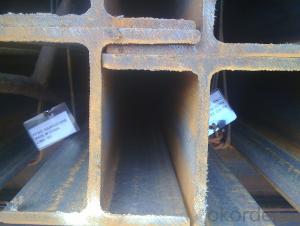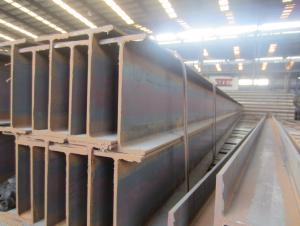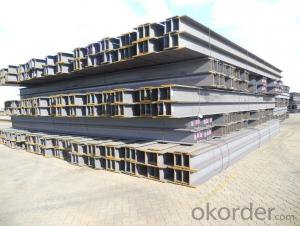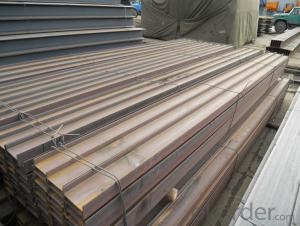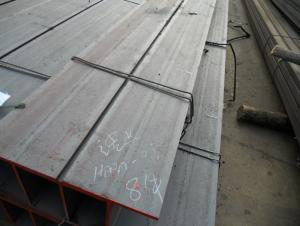Hot Rolled Steel H-Beam for support structure
- Loading Port:
- Tianjin
- Payment Terms:
- TT OR LC
- Min Order Qty:
- 15000 m.t.
- Supply Capability:
- 150000 m.t./month
OKorder Service Pledge
OKorder Financial Service
You Might Also Like
Item specifice
Product Description:
Product Description:
OKorder is offering Hot Rolled Steel H-Beam for support structure at great prices with worldwide shipping. Our supplier is a world-class manufacturer of steel, with our products utilized the world over. OKorder annually supplies products to European, North American and Asian markets. We provide quotations within 24 hours of receiving an inquiry and guarantee competitive prices.
Product Applications:
Hot Rolled Steel H-Beam for support structure are ideal for structural applications and are widely used in the construction of buildings and bridges, and the manufacturing, petrochemical, and transportation industries.
Product Advantages:
OKorder's Hot Rolled Steel H-Beam for support structure are durable, strong, and resist corrosion.
Main Product Features:
· Premium quality
· Prompt delivery & seaworthy packing (30 days after receiving deposit)
· Corrosion resistance
· Can be recycled and reused
· Mill test certification
· Professional Service
· Competitive pricing
Product Specifications:
Specifications of Hot Rolled Steel H-Beam for support structure
1. Standard: GB700-88, Q235B2.
2. Grade: Q235, SS400 or Equivalent
3. Length: 6m,10m, 12m as following table
4. Invoicing on theoretical weight or actual weight as customer request
5.Payment: TT or L/C
6. Sizes:
SIZE(mm) | DIMENSION(kg/m) |
100*100 | 16.9 |
125*125 | 23.6 |
150*75 | 14 |
150*150 | 31.1 |
148*100 | 20.7 |
198*99 | 17.8 |
200*100 | 20.9 |
248*124 | 25.1 |
250*125 | 29 |
Usage & Applications of Hot Rolled Steel H-Beam for Structure Steel
Commercial building structure ;Pre-engineered buildings; Machinery support structure; Prefabricated structure; Medium scale bridges; Ship-building structure. etc.
Packaging & Delivery of Hot Rolled Structural Steel H Beam
1. Packing: it is nude packed in bundles by steel wire rod
2. Bundle weight: not more than 3.5MT for bulk vessel; less than 3 MT for container load
3. Marks:
Color marking: There will be color marking on both end of the bundle for the cargo delivered by bulk vessel. That makes it easily to distinguish at the destination port.
Tag mark: there will be tag mark tied up on the bundles. The information usually including supplier logo and name, product name, made in China, shipping marks and other information request by the customer.
If loading by container the marking is not needed, but we will prepare it as customer request.
4. Delivered by container or bulk vessel
Production flow of Hot Rolled Structural Steel H Beam
Material prepare (billet) —heat up—rough rolling—precision rolling—cooling—packing—storage and transportation
FAQ:
Q1: Why buy Materials & Equipment from OKorder.com?
A1: All products offered byOKorder.com are carefully selected from China's most reliable manufacturing enterprises. Through its ISO certifications, OKorder.com adheres to the highest standards and a commitment to supply chain safety and customer satisfaction.
Q2: How do we guarantee the quality of our products?
A2: We have established an advanced quality management system which conducts strict quality tests at every step, from raw materials to the final product. At the same time, we provide extensive follow-up service assurances as required.
Q3: How soon can we receive the product after purchase?
A3: Within three days of placing an order, we will begin production. The specific shipping date is dependent upon international and government factors, but is typically 7 to 10 workdays.
Images:
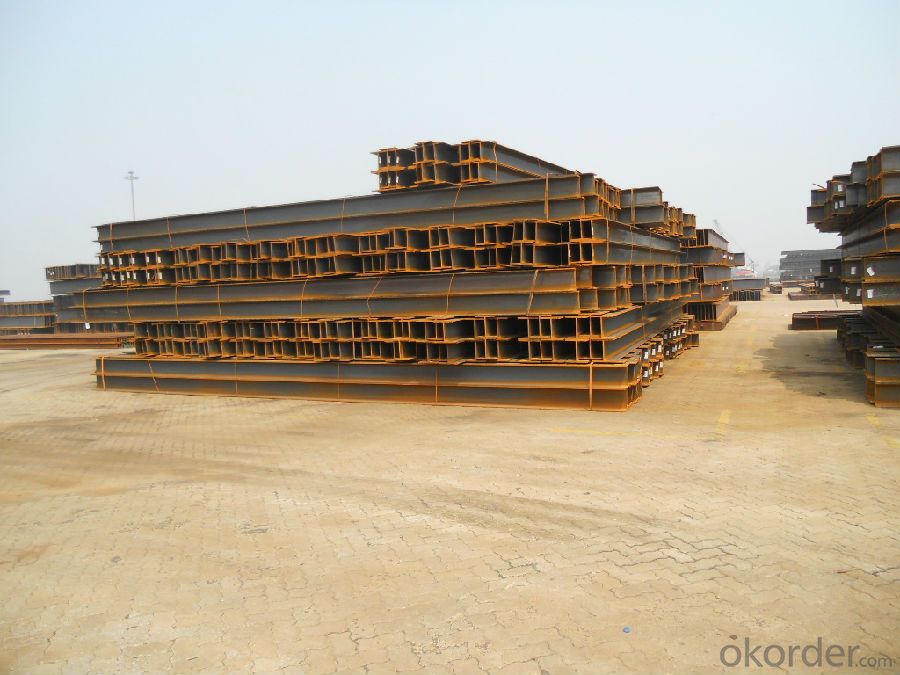
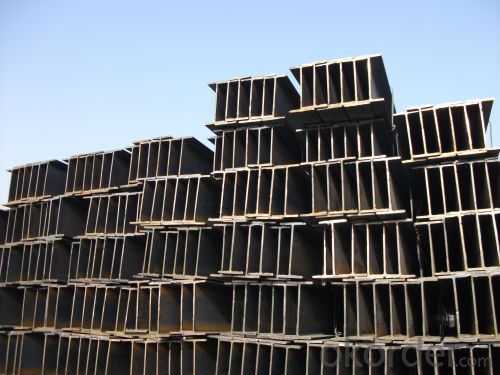
- Q:Can steel H-beams be used for supporting solar panels?
- Absolutely! Steel H-beams are an excellent choice for supporting solar panels. These beams are widely used in construction as they possess remarkable strength, durability, and load-bearing capabilities. When it comes to solar panel installations, H-beams provide a robust framework that securely holds and supports the panels. With the inherent strength of steel, the beams can effortlessly withstand the weight of the panels, even in challenging weather conditions. Additionally, steel's versatility allows for customization and adaptability to meet various installation requirements. Whether it's a rooftop or ground-mounted solar array, steel H-beams can effectively serve as the primary support structure for solar panels.
- Q:What are the different types of connections for steel H-beams in industrial buildings?
- Steel H-beams in industrial buildings commonly employ different types of connections to enhance stability and strength, thereby effectively supporting the loads they bear. 1. Welded Connection: Welding the ends of H-beams together forms a robust and rigid connection, making it one of the most prevalent methods. This connection is ideal for axial loads, facilitating efficient load transfer between the beams. 2. Bolted Connection: Bolted connections involve using bolts and nuts to join H-beams. Drilling holes in the flanges and webs of the beams allows for inserting bolts, which are secured with nuts. Bolted connections offer the advantage of easy disassembly and modification, making them suitable for situations requiring flexibility. 3. Pinned Connection: Pinned connections enable the free rotation and movement of H-beams. By inserting a pin or bolt through the flanges, movement and rotation become possible. This connection is often used in structures exposed to seismic or dynamic forces. 4. Moment-Resisting Connection: Designed to resist bending moments and provide stability, moment-resisting connections are commonly used in multi-story industrial buildings or structures subject to high wind or seismic loads. These connections typically combine welding and bolting techniques, ensuring a secure and rigid joint. 5. Shear Connection: Shear connections facilitate the transmission of shear forces between H-beams. This connection is typically achieved through welding or bolting plates or angles to the webs of the beams. Shear connections play a crucial role in transferring lateral loads and ensuring the structural integrity of the building. The selection of the connection type for steel H-beams in industrial buildings depends on various factors, including structural design, loading conditions, flexibility requirements, and construction methods. Engineers carefully consider these factors to determine the most appropriate connection type that guarantees the safe and efficient performance of the structure.
- Q:Which is better, I-beam or HN steel?
- Mainly to see what you mean, I-beam and HN steel beams of what size, or look at section size. Generally I-beam is stronger
- Q:Can steel H-beams be used for sports arenas?
- Sports arenas can indeed utilize steel H-beams. These beams are widely employed in the construction field because of their impressive strength, durability, and capacity to bear heavy loads. Given that sports arenas often necessitate spacious interiors and lofty ceilings, steel H-beams possess the necessary structural support required for such designs. Furthermore, the fabrication and assembly of steel H-beams are straightforward, rendering them a cost-efficient option for constructing sports arenas. Additionally, steel exhibits resistance against fire, pests, and natural elements, rendering it a dependable material for long-term usage in sports arenas. All in all, the robustness, versatility, and cost-effectiveness of steel H-beams make them a fitting choice for the construction of sports arenas.
- Q:Are steel H-beams cost-effective compared to other beam options?
- Steel H-beams are generally considered a cost-effective option compared to other beam choices. There are multiple factors that contribute to this cost-effectiveness. To begin with, steel H-beams have a high strength-to-weight ratio, allowing them to support heavy loads while remaining relatively lightweight. This leads to cost savings in terms of transportation, installation, and foundation requirements. Moreover, steel H-beams are durable and have a long lifespan. They are resistant to corrosion, fire, and pests, resulting in minimal maintenance and replacement costs over time. Furthermore, steel H-beams are easily manufactured and readily available. This enables large-scale production at a low cost, making them more affordable than alternative beam options. Additionally, the availability of standardized sizes and shapes simplifies the design and construction process, further enhancing their cost-effectiveness. It is important to note that the cost-effectiveness of steel H-beams may vary depending on specific project requirements and local market conditions. However, in general, steel H-beams offer a combination of strength, durability, and affordability that make them a cost-effective choice for many construction projects.
- Q:Are steel H-beams resistant to seismic forces?
- Yes, steel H-beams are highly resistant to seismic forces. The structural integrity of H-beams, combined with their ability to distribute and dissipate seismic energy, makes them an ideal choice for earthquake-resistant construction.
- Q:How do steel H-beams perform in areas with high humidity and moisture?
- Steel H-beams perform well in areas with high humidity and moisture due to their inherent durability and resistance to corrosion. The steel used in H-beams is typically coated with protective finishes such as galvanization or paint, further enhancing their resistance to moisture-related damage. This ensures that they maintain their structural integrity and strength even in challenging environments.
- Q:What are the typical fabrication tolerances for steel H-beams?
- The typical fabrication tolerances for steel H-beams vary depending on several factors such as the specific application, industry standards, and the manufacturer's capabilities. However, some commonly accepted tolerances for steel H-beams include: 1. Dimensional Tolerances: These refer to the allowable variations in the physical dimensions of the H-beam, including the height, flange width, web thickness, and overall length. The tolerance range can typically be within a few millimeters or even fractions of a millimeter, depending on the specific requirements and standards. 2. Straightness Tolerances: Straightness is a critical aspect of H-beam fabrication, as it ensures proper alignment and fit in construction projects. The allowable straightness tolerance for steel H-beams is typically specified in terms of a maximum deviation from a straight line over a certain length. This tolerance is usually expressed in millimeters or inches per meter or foot. 3. Surface Quality Tolerances: Surface imperfections such as dents, scratches, or other defects can impact the overall performance and aesthetics of steel H-beams. The acceptable surface quality tolerances for H-beams may vary depending on the intended use and customer requirements but are generally within industry standards. It is important to note that these tolerances can vary across different standards and specifications, such as those set by organizations like the American Institute of Steel Construction (AISC), European Committee for Standardization (EN), or the International Organization for Standardization (ISO). Additionally, manufacturers may have their own specific tolerances based on their capabilities and quality control processes. To ensure compliance with specific project requirements, it is crucial to consult the relevant standards and communicate with the manufacturer or supplier to understand the exact fabrication tolerances for steel H-beams.
- Q:Can Steel H-Beams be used in airport or transportation terminal construction?
- Steel H-Beams are indeed applicable for airport or transportation terminal construction. They are commonly utilized in construction ventures that necessitate structural reinforcement, such as airports and transportation terminals. These beams possess exceptional load-bearing capabilities and can endure heavy loads, rendering them suitable for erecting extensive structures like airports and terminals. Moreover, they are recognized for their robustness and extended lifespan, which are pivotal for infrastructure projects. Furthermore, Steel H-Beams can be effortlessly produced and incorporated, thereby facilitating efficient construction procedures. Overall, Steel H-Beams are a favored option in airport and transportation terminal construction owing to their potency, longevity, and easy installation.
- Q:How do steel H-beams contribute to sustainable building certifications?
- Steel H-beams have a significant impact on sustainable building certifications in various ways: 1. Enhancing Energy Efficiency: Structural frames made from steel H-beams maximize energy efficiency by providing a high strength-to-weight ratio. This allows for the use of smaller columns and beams, reducing the need for excessive amounts of steel and concrete. Consequently, energy consumption during both construction and operation of the building is reduced. 2. Promoting Recyclability: Steel H-beams are manufactured using recycled materials and can be fully recycled at the end of their lifespan. This makes them an excellent choice for sustainable construction, as they can be reused or repurposed. This not only reduces the demand for new materials but also minimizes waste generation. 3. Ensuring Durability and Longevity: Steel H-beams possess exceptional durability and can withstand extreme weather conditions, seismic activities, and fire. This longevity eliminates the need for frequent maintenance or replacement, resulting in lower life-cycle costs and a reduced environmental impact throughout the building's lifespan. 4. Minimizing Waste and Emissions: The precise manufacturing process of steel H-beams results in minimal construction waste. Furthermore, their lightweight nature enables easier transportation and handling, thereby decreasing carbon emissions associated with transportation and installation. 5. Offering Design Flexibility: Steel H-beams provide architects and engineers with greater design flexibility, enabling the implementation of innovative and sustainable construction practices. Their ability to span larger distances without additional support columns allows for open floor plans and maximizes natural light, reducing the reliance on artificial lighting and enhancing indoor environmental quality. 6. Contributing to LEED Certification: Steel H-beams can earn points towards LEED certification, a globally recognized sustainability rating system for buildings. Their efficient utilization of materials, energy, and resources aligns with several LEED criteria, including Sustainable Sites, Energy and Atmosphere, Materials and Resources, and Innovation in Design. In conclusion, steel H-beams play a critical role in obtaining sustainable building certifications by offering energy efficiency, recyclability, durability, waste and emission reduction, design flexibility, and the potential to contribute to LEED certification. Their sustainable attributes make them the preferred choice for environmentally conscious builders and significantly contribute to achieving sustainable building goals.
1. Manufacturer Overview |
|
|---|---|
| Location | |
| Year Established | |
| Annual Output Value | |
| Main Markets | |
| Company Certifications | |
2. Manufacturer Certificates |
|
|---|---|
| a) Certification Name | |
| Range | |
| Reference | |
| Validity Period | |
3. Manufacturer Capability |
|
|---|---|
| a)Trade Capacity | |
| Nearest Port | |
| Export Percentage | |
| No.of Employees in Trade Department | |
| Language Spoken: | |
| b)Factory Information | |
| Factory Size: | |
| No. of Production Lines | |
| Contract Manufacturing | |
| Product Price Range | |
Send your message to us
Hot Rolled Steel H-Beam for support structure
- Loading Port:
- Tianjin
- Payment Terms:
- TT OR LC
- Min Order Qty:
- 15000 m.t.
- Supply Capability:
- 150000 m.t./month
OKorder Service Pledge
OKorder Financial Service
Similar products
New products
Hot products
Related keywords
